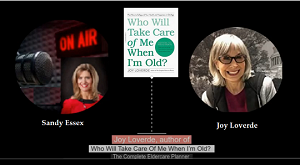Please contact me now for more information! Click this link to schedule a meeting with Sandy
Long Term Care Awareness Month ” Beyond Dollars Study 2021″
Shows Increasing Need for Long Term Care and Reliance on Family Members

Industry Leaders have conducted studies approximately every three years since 2010 as part of its mission to help families prepare for the challenges of their and their loved ones’ aging. The study documents the impact of caregiving on families beyond the cost of long-term care services, which Genworth tracks in its annual Cost of Care Survey.
“While the experience of caregiving can be rewarding, the physical, financial, emotional and psychological strain of caring for a loved one is deep and real for caregivers, and their family and friends,” said Brian Haendiges, President and CEO, Genworth U.S. Life Insurance. “At Genworth, we know this all too well. In addition to our more than 40 years helping our policyholders and their families navigate these challenges, many of us, like those families across the US, have a personal long-term care story. No one is immune to aging or its impacts, and this year’s research further emphasizes the need for us to work together to solve the long-term care crisis before us.”
Following are some highlights of this year’s study:
Growing Needs
Increasing lifespans mean that the likelihood that you or a loved one will live through an event that requires long-term care is increasing as well. As the population gets older and medicine improves, the prevalence in the population of conditions that require long term care―and the length of time that people live with such conditions―increase as well. And as loved ones adapt to their “new normal,” they prefer the comforts of home. Findings include:
- Care is becoming more complex: 49% of care recipients require help in “all aspects of daily living” and only 8% needing “very minor assistance,” up and down from 39% and 12% respectively in 2018. Moreover, relative to the 2018 study, more people suffered from age-related physical limitations (47%, up from 44%) and accidents requiring rehabilitation (23%, up from 21%), but the biggest jump was in cognitive impairments (32%, up from 26%).
- Needs are becoming more acute: Care is lasting longer, with the average duration of a care event, according to this study, going from 3 years in 2018 to 3.5 years in 2021.
- People prefer care at home, but there are challenges: A large majority of care recipients ―79% in 2021― prefer at-home care to facility care. Echoing similar data from 2018, in 42% of cases, a loved one provided care in a care recipient’s home, and in 26% of cases, a professional caregiver provided the in-home care. But between 2018 and 2021, the proportion of care recipients who moved in with a loved one to receive care dropped significantly, from 21% in 2018 to 12% in 2021, possibly attributable to concerns about COVID-19 exposure, especially if the familial caregiver has children living at home as well.
Family Matters
As the need for care increases, family members are filling in the gap, with one in three Americans reporting that they unexpectedly became caregivers, with adults reporting the need to carve out an average of approximately 19 hours a week to provide care. However, the responsibility to provide care does not fall equally across families―nor do the hardships imposed by doing so. Findings include:
- Providing care affects family members’ ability to work. Many family caregivers, including 56% of women and 45% of men, reported that providing care “negatively affected” their ability to satisfy the requirements of employment. Similarly, 40% of men and 27% of women believed that they had lost a majority or more of their annual income as a result of caregiving.
- But increased flexibility on the part of employers due to the pandemic may have reduced the strain; in 2018, 46% of caregivers reported having to work fewer hours and 35% cited “repeated absences” due to the need to provide care, these figures dropped to 38% and 27% respectively in 2021. However, it is unclear whether flexibility from employers will continue post-pandemic.
- The financial burden of providing care is weighing more heavily. In 2021, familial caregivers were about as likely to report using savings/retirement funds (66% vs. 63%), cutting back on luxury expenditures (63% vs. 60%) for care compared to 2018, but they were considerably more likely to report reducing contributions to savings/retirement funds (54% vs. 42%), spending funds intended to be given as an inheritance (50% vs. 38%), selling personal possessions (43% vs. 35%), cashing out life insurance policies (41% vs. 26%) and borrowing money from friends or family members (40% vs. 31%).
- But the burden goes beyond economics. Of women, 59% reported that providing care had negatively affected their own health, compared to 43% of men. Almost half (48%) of in-home caregivers reported symptoms of stress, 46% reported less time to spend on themselves or others and 42% reported being in a negative mood. In addition, significant portions of family caregivers also reported experiencing sleep deprivation, insomnia, a sense of isolation, guilt and/or weight gain as a result of providing care.
A Shared Experience
Overall, the physical, financial, emotional, and psychological strain of caregiving is experienced across demographics. Our data shows that the experience of needing care and providing care for a loved one does not vary depending on one’s ethnicity. While there were some differences in perspective, the vast majority of experience and approach data does not differ significantly based on one’s identified ethnicity. Survey participants this year were 18% Hispanic, 10% African American and 5% Asian, reflective of how ethnic populations are represented in the 2020 U.S. census.
Looking Ahead to Better Outcomes
In a world where more people are caregivers, Americans are looking at the experiences of their loved ones and thinking about how they can age as comfortably as possible―while reducing strain on their families. Long Term Care Insurance can provide flexibility to receive professional-level care either at home or in assisted living facilities1, an increasingly appealing offering as the need for care becomes more likely. Findings include:
- Long Term Care Insurance (LTCI) helps reduce financial hardship. In only 23% of situations did care recipients use some form of insurance providing coverage; in 14% of cases, LTC insurance was used, with life insurance riders allowing for long-term care and annuities with care provisions also being utilized. Of beneficiaries who utilized LTC insurance coverage, 61% reported out-of-pocket costs of $500 or less, despite being more likely to utilize costly assisted living facilities.
- Long Term Care Insurance (LTCI) can provide flexibility in where care is received, as well as peace of mind. Holders of Long Term Care Insurance (25%) were significantly more likely than non-holders (11%) to receive care in an assisted living facility, where residents may have more space and better accommodations than nursing homes typically provide. And those who were able to take advantage of LTCI benefits were less likely to experience stress as a result of the need for care: 34% of policyholders, as opposed to 47% of non-holders.
- People are taking notice and thinking ahead. As previously reported, Genworth’s COVID-19 Consumer Sentiment survey found that adults’ attitudes toward long-term care and financial planning has changed, with 4 out of 5 adults having already taken some action to increase their level of financial preparedness due to lessons learned from COVID-19.
Planning Resources
Planning well in advance expands the choices available for care later as people grow older. Following are resources that can help with the planning process:
- Visit https://www.genworth.com/aging-and-you/finances/cost-of-care.html to learn more about the cost of long term care in your area and how costs have changed over time.
- Learn more about the physical, financial, emotional, and psychological strain caregiving can have on family, friends, and society.
- To explore long term care financing options, please visit genworth.com/longtermcare
About the Beyond Dollars Study 2021
Genworth sponsored the Beyond Dollars Study in 2010, 2013, 2015, 2018 and now in 2021 to understand and share the perspectives of care recipients, familial caregivers and their wider support network.
Genworth conducted its latest Beyond Dollars Study in April 2021. The initial research population included 4,695 participants, of whom 1,325 qualified to participate based on their situations and experience. Qualified participants included 963 people providing long term care to loved ones (caregivers), 299 care Recipients and 63 family members with detailed knowledge of a long-term care event in their family (but not responsible for providing care).
When extrapolating to the total population of people requiring long term care services, this study looks at the responses provided by caregivers, the largest, most representative group, as opposed to the portion of survey participants qualifying as care recipients, a group that skews from the total population by nature of their physical and/or cognitive ability to participate in this online survey.
40% percent of caregivers were providing care for a parent, step-parent or parental in-law (23% for their mother, 10% for their father). 46% were caring for a spouse and 3% for a grandparent. 8% were providing long-term care for a sibling or child.
Caregivers were essentially evenly split between male and female, challenging a commonly held assumption that the caregiving role predominantly becomes women’s responsibility. Their average age was 51, and 72% were married. 60% of the loved ones receiving care were women, with an average age of 61, of whom 34% were married. A dedicated effort was made to ensure the survey population was ethnically representative of the United States.
Click here to read the Executive Summary of Genworth’s Beyond Dollars Study 2021.
Sandy Essex,
CLTC Long Term Care Planning Advisor
847.695.6690
Visit us at www.BestLtcAdvice.com
CLICK HERE to see the COST Of CARE IN YOUR AREA
To send me a Secured Email click here!
We take care of tomorrow, so you can focus on today!
I look forward to helping you and any friends or family members that have not planned.






